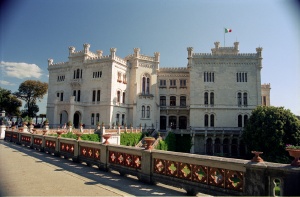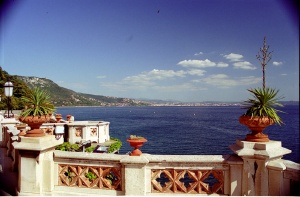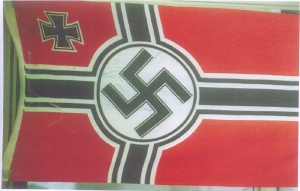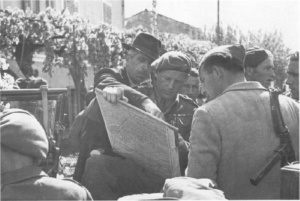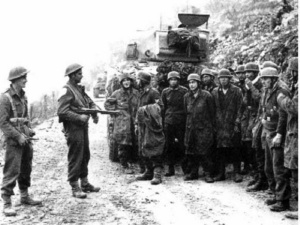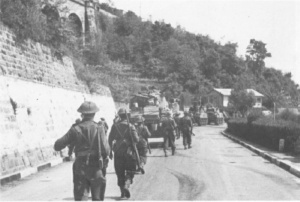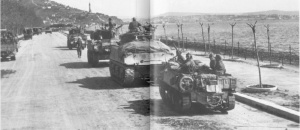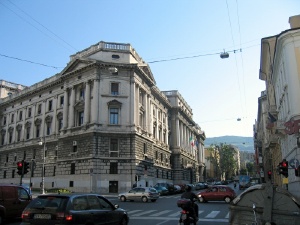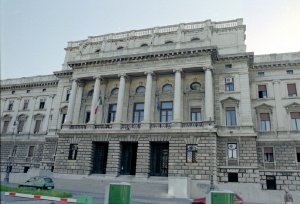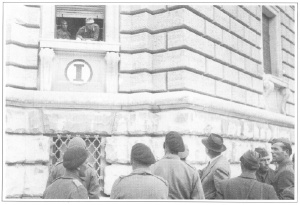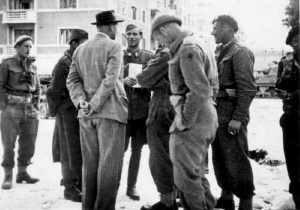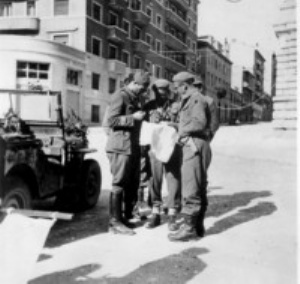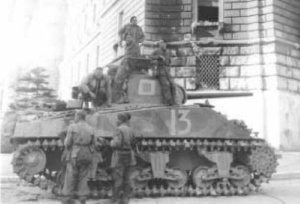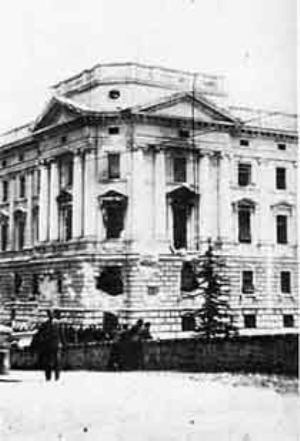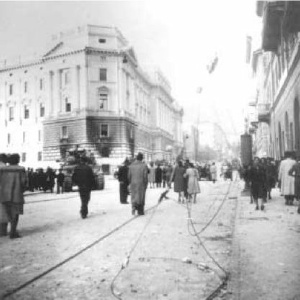22 Battalion Enters Trieste
On 2 May 1945 A and C Companies of 22 Battalion raced northward along
the Adriatic Coast towards Trieste. Their mission was two-fold, to
enter Trieste and end the war in Italy, and to get there ahead of other
elements of the 8th Army, in particular Div Cav who were taking the
high road above the town. Despite some reports in the official history
to the contrary, it was 22 Battalion that entered the city first. As
they entered, they found that the Yugoslav partisans had already
arrived, and dealing with them complicated the issues.
I have located a number of photos taken as the New Zealanders entered Trieste, and of the incidents that followed.
Miramare castleMiramare
lies on the coast about 5km south of Trieste. It was the HQ for a
German Division, but they quietly surrendered to A Company of the 22nd.
The large German flag that flew over the castle was removed by A
Company, who all signed their names on it. The flag is now on permanent
display in the Waiouru Army Museum.
|
Miramare Castle, taken in 2005l
|
The view from Miramare towards Trieste
|
The German flag removed by "A" Company, 22 Battalion on 2 May 1945
|
The road to TriesteThe
22nd Battalion was stopped at a number of points on the road into Trieste,
clearing roadblocks and dealing with Germans only some of whom wished to surrender.
Eventually LTCOL Haddon Donald was approached by a group of Germans
which included an officer and radio operator. They accompanied Haddon
into Trieste, navigating and advising local German units of their
arrival.
|
Haddon Donald seeking directions
|
Haddon's jeep nearing Trieste
|
Guarding prisoners near Trieste
|
|
Approaching Trieste
|
Near Trieste
|
The last past of the road
|
|
Approaching Trieste
|
Near Trieste
|
The last past of the road
|
Entering Trieste
The 22nd Battalion was followed
into Trieste by the Lancers and some armour under their command. They
were welcomed by the Triestini, but the Yugoslav partisans were less
keen, althought here are several photos showing the two forces geting
on well together.
|
Colma and Margaret enjoying the view.
|
Walls made from slabs of sandstone
|
Trace fossils in the slabs
|
|
The Cliffs to the south
|
The Cliffs to the North
|
Another view to the south
|
|
The Stack
|
To the north and O'Brien's Castle
|
The Cliffs close up with resting birds
|
The Tribunale Building
For
Colonel Donald and the New Zealanders who first arrived in Trieste, the
Tribunale (Law Courts) building was occupied by belligerent SS officers
who refused to surrender. To quote the
Official History:
|
"At the
Tribunale Donald could not persuade the garrison commander to
surrender; he was an SS officer who ‘was still
humbugging undecidedly and was apparently under the influence of
alcohol.' Donald therefore arranged with the Yugoslav commander
that tanks of C Squadron of 19 Regiment and C Squadron of the 20th
would surround the building and give it a 20-minute pounding with their
guns and Brownings. First the square was cleared of all troops and
civilians, and at 7 p.m. 18 tanks at ranges of from 20 to 50 yards blew
gaping holes in the walls and through the windows of the Tribunale. The
Germans took shelter in the cellars and had few casualties, but the
Yugoslavs entered the building and by morning had rounded up some 200."
|
The
shelling of the Tribunale was one of the few incidents of damage
inflicted by the New Zealand troops on arrival at Trieste. A few
photographs survive from the event.
|
Front of the Tribunale today. Note the windows in the corner face
|
Main frontage of the Tribunale today
|
Main frontage of the Tribunale today
|
|
Front of the Tribunale today. Note the windows in the corner face
|
Main frontage of the Tribunale today
|
Main frontage of the Tribunale today
|
In his book "In Peace and War", Lt Col Haddon Donald, commander of the 22 Battalion, recalls:
"....I decided to try on my
own to persuade them to surrender. With no flag of truce available, I
made do with my handkerchief, which was white and reasonably large... I
knew enough Italian and German to be able to explain who I was... and
we would give them safe conduct back to a British prisoner of war
camp.....They stepped back inside and slammed the door."
"I was fast losing patience with the SS types in the Tribunale, but
decided to have one more go at offering then safe conduct.... Terry
McLean, my adjutant, could speak some German and by this time an
Austrian civilian had joined us to act as an interpreter. The three of
us, under a better constructed white flag marched once more across the
Square to parley with the Germans."
"I gave the order to fire and keep firing until we had blown several
entries into the building.... The tank boys were having a wonderful
time. Never had they had such an easy target and nobody was shooting
back at them." |
|
One of several conferences between Germans occupying the Tribunale and New Zealanders. Note the window.
|
Trying to decide what to do
|
|
About the time of the second trip to the front door of the Tribunale. Note the "better" white flag in the foreground
|
The tanks lined up ready to fire. Again note the window.
|
|
After the tanks - note the window is now blown apart and the smoke damage on many of the windows.
|
The corner of the Tribunale from a distance, and the window with smoke scars.
|
Castle San GiustoOverlooking
Trieste and its harbour is the ancient castle of San Giusto, lying next
to the cathedral of XX. The castle housed a German garrison and as they
occupied a commanding position over the city, Haddon Donald decided
they needed to be removed as soon as possible. He sent C Company, led
by Major Lloyd Cross, up to the castle where they met the CO, an
Admiral. He was willing to surrender but the Yugoslav partisans had
other ideas, threatening to shoot any person, German or Allied, who left
the building. As Major Cross only had a depleted company, and no tanks
or armour, he decided to stay in the castle until relieved. The Admiral
pointed out that the Kiwis only had a small force whereas the Yugoslavs
had a heavily armoured force. Disretion prevailed, and although the
Germans piled most of their arms into a room, but sentries were posted
around the castle that night of Kiwis alternating with Germans - a most
bizarre end to the war. But as Major Cross pointed out to the Admiral,
his troops had not eaten since breakfast and they had not brought
rations with them. The Admiral sat them down to eat with his men. The
menu was stew - made from horsemeat. Major Cross dined with the German
officers, and they had stew - from horsemeat, washed down, not with
Italian wine or good brandy, but Scotch whisky, the last remnants from
the fall of Tobruk.
The official history records the facts:
| A
company of the 22nd Battalion proceeded to the 750-year-old castle of
San Giusto, the ancient citadel of the port, to receive the surrender
of nine officers and 260 men. In the central courtyard, the company
drew up opposite the paraded garrison, and returned the salute in a
ceremony which had all the appurtenances of a military occasion.
Bullets from Yugoslav snipers pattered against the old walls. As the
prisoners moved out the following day partisans demanded that
the Germans be handed over to them. Tactful handling prevented trouble. |
Here are some photos of that
time at San Giusto, together with photos I took in 2005. Note that the
Cenotaph flanked by yew trees figures in both sets of photos.
|
Colma and Margaret enjoying the view.
|
Walls made from slabs of sandstone
|
Trace fossils in the slabs
|
|
The Cliffs to the south
|
The Cliffs to the North
|
Another view to the south
|
|
The Stack
|
To the north and O'Brien's Castle
|
The Cliffs close up with resting birds
|
Return to main index
Last updated: 7/12/2009
|
